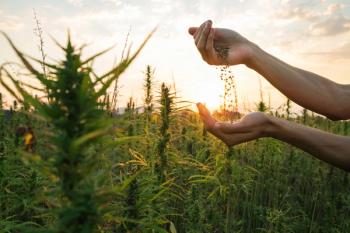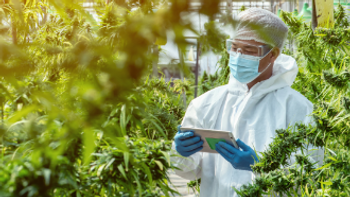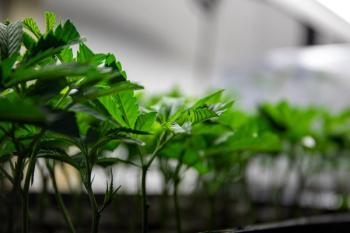
Cannabis Science and Technology
- September 2020
- Volume 3
- Issue 7
Invasion of the Drones: How Unmanned Aerial Vehicles Can Help Cannabis Growers Improve Crop Quality, Lower Costs, and Save the Planet
A closer look at the benefits of incorporating drone technology into commercial cannabis operations.
Drones will soon become an integral part of commercial cannabis cultivation. From open-air farms to indoor grow ops, drones can help cultivators operate a more efficient business, produce healthier plants, reduce their carbon footprint, and decrease their overall cost of production. Although drone use is not yet commonplace among cannabis growers, this is certain to change as cultivators learn more about the benefits of incorporating this technology into their commercial operations.
A drone is an unpiloted aircraft. Officially referred to as an unmanned aerial vehicle (UAVs), a drone is essentially a flying robot that can be controlled remotely or flown autonomously. Originally developed for military and aerospace applications, drones are becoming increasingly popular among hobbyists and photographers alike. In agriculture, they are playing a more integral role in the crop production process, helping farmers to gather data and perform tasks more quickly and more consistently than ever before.
This article explores the benefits of integrating drones into commercial cannabis operations and helps the reader decide which technology is appropriate for their business.
Indoor
Researchers are developing innovative applications for the use of drones in indoor vertical grow environments. Indoor vertical farms typically have high ceilings and multiple levels of production that can present scouting challenges for the cultivation team. Plant inspections allow growers to catch plant problems before they get out of hand, and in vertical grow operations this involves pushing around rolling ladders and spending most of the work day climbing up and down them. Accessing each level of plant production can be difficult and time-consuming, and this process is neither consistent
or efficient.
Enter the drones. In Denmark, a partnership between Arhus University Engineering College and Nextfood, a technology company that develops vertical farming systems, has resulted in a prototype Indoor Image Acquisition Drone, or IIAD, to help growers monitor plant health and prevent crop damage in vertical growing situations. Made with a compact frame for maneuvering in tight spaces, the IIAD uses three onboard cameras that allow it to navigate inside of a warehouse without relying on global positioning systems (GPS) or indoor positioning systems (IPS). One downward facing camera is used for following lines that lead the drone to each growing station, while a front facing camera is used for positioning, imaging, and reading QR codes. Using ultrasonic sensors, the drone is designed to avoid obstacles along its route, and can fly between different levels of plant production with ease. The IIAD can recognize individual plants by reading their QR codes and through subsequent image analysis can provide insight into plant maturity, nutrient deficiencies, and potential disease problems.
Greenhouse
Cannabis growers can benefit from incorporating drone technology in their greenhouse operations to help control flying insects like moths. Although moths don’t eat cannabis plants, their offspring do. Given their light green color, many caterpillars seamlessly blend into the crop and can feed unnoticed until severe damage becomes visible to the naked eye. In addition to damage from feeding, caterpillar feces can render cannabis flowers unsaleable. Until now, growers could only screen moths from entering their facilities, since most pesticides used for controlling caterpillars are prohibited for use on cannabis crops.
PATS Indoor Drone Solutions in the Netherlands is developing a drone that eradicates flying pests without the use of manual labor or pesticides. Their solution involves the use of base stations mounted throughout the greenhouse that continuously scan the cultivation environment for harmful flying insects. Once an insect is detected, the base station launches a mini-drone to seek and destroy the flying insect by sucking the insect into their propellers. Once the insect is eliminated, the drone returns to the base station.
Although still in development, the use of these mini drones has the potential to provide growers a completely autonomous pest control solution while helping to eliminate insecticide use and the labor required to apply them. “Making a plan, scouting, and doing treatments is very laborious,” says Bram Tijmons, CEO and cofounder of PATS Indoor Drone Solutions. “We want to be better than the alternatives that exist right now, and our technology is a better fit with integrated pest management programs.”
Farms
Outdoor cannabis cultivation holds the greatest number of potential uses for drones. This is because outdoor farms are usually several acres in size, with some hemp plantations exceeding 100 acres. Drones allow farmers to decrease money spent on manual field labor, while increasing the consistency of the task performed. This results in a lower cost of production, while increasing both the volume and quality of plants cultivated. Now let's discuss six of the most promising uses of drones for outdoor cultivators of cannabis: soil analysis, crop mapping and surveying, seed planting, irrigation management, flowering cycle interruption, and pest and disease management.
Soil Analysis
Drones can help farmers analyze their land prior to planting large crops. By equipping drones with specialized sensors and cameras, farmers can accurately assess the quality of a field prior to planting. Armed with data compressed into an easy-to-read format, a farmer can choose to avoid planting in consistently wet areas of a farm or where the soil is of poor quality. If the farmer choses to amend the soil to make it more conducive for cultivation, they only need to amend the affected areas identified by the drone’s analysis, instead of broadly amending the entire field.
Crop Mapping and Surveying
Once a crop is growing in the field, these same sensors and cameras can provide farmers with valuable data that is critical to maintaining plant health. Nutrient deficient plants or infestations from damaging insects will appear different than the rest of the crop. The cultivator can use this information to apply fertilizer in select areas of the farm or spot spray pesticides to affected areas. This saves the time and money from broadly applying these materials to the entire crop when it is not necessary. Drones can also be used to inventory the crop by plant count and even help to predict yields prior to harvest.
Seed Planting
When cannabis is seeded directly into the ground, not every seed germinates. This happens when seeds are of poor quality, the environmental conditions are not conducive to germination, or they get eaten by animals. Drones can help identify “dead spots” in the field shortly after the crop begins to emerge and then be dispatched to re-seed these areas. Some drones can handle a payload in excess of 20 lbs, so they can also carry water to irrigate the seeds once they have been dropped.
Irrigation Management
Armed with thermal and infrared cameras, drones can help farmers use less water to grow their crops. Overhead views of a field can help identify leaks and malfunctioning irrigation equipment, as well as dry areas or chronically waterlogged soil. Identifying and fixing these problems early can help improve plant health and prevent water waste.
Flowering Cycle Interruption
Cannabis crops are photoperiodic, meaning they initiate flowering once they are exposed to long, uninterrupted periods of darkness. This can present a problem for growers that seed directly into the ground, or transplant rooted clones outdoors when nighttime is still longer than daylength. Seedlings can begin flowering shortly after emerging from the ground, and rooted clones can begin flowering just after being transplanted. This can result in extremely short plants and an accompanying small yield. To prevent premature flower onset, outdoor growers must break up long nights by using interruption lighting, which can provide a logistical problem since most outdoor crops are several acres in size.
To solve this problem, drones carrying lights can be programmed to fly over crops at night, very slowly and just above the plant canopy. By making multiple passes, or by using multiple drones, enough light can fall on the crop to prevent it from prematurely going into flower. The cost of renting and operating the drones would be far less than the cost of mounting a comprehensive lighting infrastructure over several acres of farmland.
Pest and Disease Management
Pesticide and fungicide applications are much more consistent and precise using drones. Until now, crop dusting airplanes, helicopters, and tractors have been the go-to method for spraying large fields. However, these methods are not ideal, since coverage can be sporadic and subject to prevailing winds. For mountainous crops, it can be difficult for airplane pilots to maintain a consistent flight height, and tractors aren’t much help over steep terrain.
In contrast, sensors on drones can automatically adjust height according to the terrain, ensuring spray accuracy and even application rates in the face of wind gusts and changing flight speeds. Drones can also fly much closer to the crop, ensuring consistent coverage across the field. For cultivators that battle damaging pests with beneficial insects, drones can be programmed to evenly distribute these insects over tall crops and challenging terrain that would otherwise be difficult for employees to access. Drone application of biologicals can result in reduced labor, faster applications, and more consistent distribution over large areas.
Laws and Permits
Operating a drone for commercial purposes in the United States requires certification by the Federal Aviation Administration (FAA). To receive a commercial license, drone pilots must go through much of the same training as a pilot seeking certification to fly a small airplane. This is because to the FAA, a drone operated for commercial purposes is an aircraft. If the drone is not used for hobby purposes, and it weighs more than .55 lbs, the operator must receive a Remote Pilot Certificate from the FAA.
Certification requires that the operator pass an initial aeronautical test, be at least 16 years old, and be able to read, speak, and write English, as well as pass a background security check by the Transportation Security Administration. Once licensed, the operator is given a unique registration number that must be visibly and legibly displayed on their aircraft, and they must pass a recurrent aeronautical knowledge test every 24 months.
The FAA has very specific rules that must be followed to fly a commercial drone in the national airspace. Such rules include maintaining minimum distances from buildings and clouds, and the operator must maintain a visual line of sight of their drone at all times. Commercial drones can only be flown during daylight hours, and during autonomous operations where the remote pilot inputs a flight plan that results in automated flight, the operator must have the ability to take control at any point during that flight. Commercial drones must be less than 55 lbs, and pilots cannot operate more than one drone at a time. Maximum airspeed cannot exceed 100 miles per hour, and maximum height cannot exceed 400 feet.
For activities that fall outside of the above parameters, operators must obtain an independent waiver. Flying at night requires a special waiver, as does flying multiple drones at the same time, called a “swarm waiver.” Operating a drone that weighs more than 55 lbs is a different waiver, as well as flying in certain airspaces, such as close to an airport.
Types of Drones
There are basically three types of drones that are used for agricultural purposes: surveyors, sprayers, and broadcast spreaders.
Drones used for surveying crops utilize cameras to collect data from a bird’s eye view. These aircrafts don’t need to haul much weight besides a camera, so they are typically smaller and lighter than other drones used for more heavy-duty jobs. Surveillance drones can be either fixed wing models that resemble small airplanes, or multirotor drones that use various propellers. Fixed wing drones are best for covering a lot of ground in a short time, and they are capable of covering up to 10 times the acreage as a multirotor drone. Multirotor drones are best for surveillance projects that require low, slow hovering action where accuracy and high resolution images are desired. Fixed wing drones can run $10,000 to $25,000 while multirotor drones are a bit more economical, around $2,000 to $10,000.
Sprayer drones are used for spot irrigation, application of liquid fertilizer, pesticide and fungicide applications, and sanitation. The largest sprayer drones can hold up to 20 L, roughly the same volume as a standard backpack sprayer. A sprayer drone can cover approximately 25 acres per hour, and with multiple drones a farmer could cover additional acreage in the same amount of time. Even compared to tractor sprayers, drones still come out on top, allowing the farmer to cover more space much faster. Sprayer drones with a tank capacity of 10 L start around $10,000.
Broadcast spreaders are used for seeding, disbursement of pelletized fertilizer, and the distribution of beneficial insects. Like sprayer drones, broadcast spreaders must hold several pounds of weight, so they are typically larger than drones used only for surveying. Spreaders can have up to a 16 L capacity with an adjustable spreading range of up to 30 m. Growers should expect to spend around $10,000 for a drone with a payload capacity of 15 lbs.
Value
Large farms may utilize multiple drones to accomplish tasks more quickly, and they may require more than one type of drone throughout the crop cycle. In addition to the purchase price, there are also maintenance costs and licensing fees. Although these costs can collectively push six figures, it’s best to keep the purchase price in perspective. A new tractor can cost several hundred thousand dollars, and not achieve anywhere near the same efficiency of a drone. They also carry a much higher operating cost in terms of manual labor, fuel, and maintenance.
The value of a drone goes beyond just the monetary benefits and extends to a grower’s environmental impact as well. Farmers should anticipate more restrictive environmental regulations surrounding the cultivation of cannabis in the future, and the use of drones can help commercial growers set the standard for environmental stewardship. Many drones are solar-powered, so there are no emissions over the field. In greenhouses, they can be an effective method of insect control without the use of pesticides, creating a more ecologically-friendly grow operation. Outdoors, drones can maintain a spray height of just 2 feet above the plant canopy, eliminating pesticide drift and the subsequent contamination of neighboring plants and wildlife. Compared to alternatives such as crop dusters, helicopters, tractors, or manual backpack sprayers, drones win every time.
How to Start
Cannabis cultivators interested in incorporating drones into their cultivation program should consider contracting a licensed commercial drone operator. This can be a safer and less costly introduction to drones for the grower. In addition to the upfront cost of the aircraft, there are also strict permitting requirements and a considerable learning curve to successfully operate the drone. Most growers don’t have the time required to learn how to operate a drone, or the free time to troubleshoot every issue that arises during regular operation. It is less costly, less time consuming, and less risky to hire a commercial drone operator. After a few seasons, if the grower is satisfied with the results and potential return on investment (ROI) of owning a fleet of agricultural drones, the purchase is much less risky.
About the Author
RYAN DOUGLAS is a cannabis growth consultant with his own company, Ryan Douglas Cultivation, LLC, based in Gorham, Maine. Direct correspondence to:
How to Cite this Article
R. Douglas, Cannabis Science and Technology 3(7), 50-54 (2020).
Articles in this issue
about 5 years ago
The Pet Lab Syndromeabout 5 years ago
To Grind or Not To Grindabout 5 years ago
Budtender: Is That a Harmful Mold in My Bud?about 5 years ago
The Hidden Costs of Falling FilmsNewsletter
Unlock the latest breakthroughs in cannabis science—subscribe now to get expert insights, research, and industry updates delivered to your inbox.





